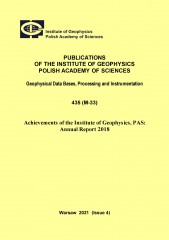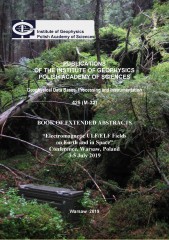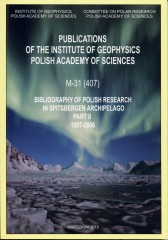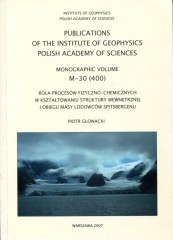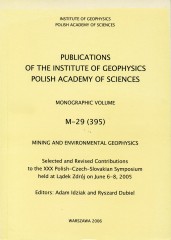BROWSE - VOLUME LIST
- A - Physics of the Earth's Interior
- B - Seismology
-
C - Geomagnetism
C-119, C-118, C-117, C-116, C-115, C-114, C-113, C-112, C-111, C-110, C-109, C-108, C-107, C-106, C-105, C-104, C-103, C-102, C-101, C-100, C-99, C-98, C-97, C-96, C-95, C-94, C-93, C-92, C-91, C-90, C-89, C-88, C-87, C-86, C-85, C-84, C-83, C-82, C-81, C-80, C-79, C-78, C-77, C-76, C-75, C-74, C-73, C-72, C-71, C-70, C-69, C-68, C-67, C-66, C-65, C-64, C-63, C-62, C-61, C-60, C-59, C-58, C-57, C-56, C-55, C-54, C-53, C-52, C-51, C-50, C-49, C-48, C-47, C-46, C-45, C-44, C-43, C-42, C-41, C-40, C-39, C-38, C-37, C-36, C-35, C-33, C-32, C-31, C-30, C-29, C-28, C-27, C-26, C-25, C-24, C-23, C-22, C-21, C-20, C-19, C-18, C-17, C-16, C-15, C-14, C-13, C-12, C-11, C-10, C-9, C-8, C-7, C-6, C-5, C-4, C-3, C-2, C-1
-
D - Physics of the Atmosphere
D-79, D-78, D-77, D-76, D-75, D-74, D-73, D-72, D-71, D-70, D-69, D-68, D-67, D-66, D-65, D-64, D-63, D-62, D-61, D-60, D-59, D-58, D-57, D-56, D-55, D-54, D-53, D-52, D-51, D-50, D-49, D-48, D-47, D-46, D-44, D-45, D-43, D-42, D-41, D-40, D-39, D-38, D-37, D-35, D-34, D-33, D-32, D-31, D-30, D-28, D-27, D-26, D-25, D-24, D-23, D-22, D-21, D-20, D-19, D-18, D-17, D-16, D-15, D-14, D-13, D-12, D-11, D-10, D-9, D-8, D-7, D-6, D-5, D-4, D-3, D-2, D-1
- E - Hydrology
- P - Polar Research
- M - Miscellanea
-
Online First
M - Miscellanea
Achievements of the Institute of Geophysics, PAS: Annual Report 2018
Author(s):
Volume: 435
Series: M-33
DOI: 10.25171/InstGeoph_PAS_Publs-2021-044
Volume: 435
Series: M-33
DOI: 10.25171/InstGeoph_PAS_Publs-2021-044
This Monograph, the first one in a series of yearly outlines on the main achievements of the Institute of Geophysics, Polish Academy of Sciences, is a reviewed and edited version of the Annual Report 2018. It provides information about the research done in the seven departments (Seismology, Atmospheric Physics, Lithospheric Research, Theoretical Geophysics, Hydrology and Hydrodynamics, Magnetism, Geophysical Imaging, and Polar and Marine Research), together with the Institute’s infrastructure, instrumentation, projects that have been completed or are underway, as well as editorial, educational, and many other activities.
BOOK OF EXTENDED ABSTRACTS. “Electromagnetic ULF/ELF Fields on Earth and in Space” Conference, Warsaw, Poland, 3-5 July 2019
Editor(s): Kułak A., Odzimek A.
Volume: 425
Series: M-32
DOI: 10.25171/InstGeoph_PAS_Publs-2019-002
Volume: 425
Series: M-32
DOI: 10.25171/InstGeoph_PAS_Publs-2019-002
A common topic of the conference are issues related to physics and geophysics of natural systems generating fields of frequencies in the ULF (Ultra Low Frequency – 0.003 to 3 Hz) range and ELF (Extremely Low Frequency – 3 to 3000 Hz) range. In the range below 3 Hz, atypical geophysical division of the pulsation phenomena in the Pc1-Pc6 ranges was used. Currently, after the International Telecommunication Union (ITU) introduced a new division of frequency bands, there was chaos, because the former ELF range was divided into three ranges, and one of them is called a ULF range. The division currently used includes the following bands: ELF (Extremely Low Frequency – 3 to 30 Hz), SLF (Super Low Frequency – 30 to 300 Hz) and ULF (Ultra Low Frequency 300 to 3000 Hz).
Bibliography of Polish Research in Spitsbergen Archipelago. Part II: 1997-2006
Editor(s): Giżejewski J.
Volume: 407
Series: M-31
Volume: 407
Series: M-31
We are giving to the still growing community of people interested in Spitsbergen and its surroundings a second part of the Bibliography of Polish Research in Spitsbergen Archipelago, covering the years from 1997 to 2006. The aim of the editors was to gather bibliographic information on scientific papers of Polish researchers. In some cases, we took into account foreign authors who closely cooperated with Polish teams in the area of Spitsbergen and around: Greenland, Iceland, Greenland Sea, Barents Sea, and the Russian Arctic. We also included publications of popular-science and informative character, which contribute to the history of research in the period covered by the Bibliography.
Rola Procesów Fizyczno-Chemicznych w Kształtowaniu Struktury Wewnętrznej i Obiegu Masy Lodowców Spitsbergenu (Role of Physical and Chemical Processes in the Internal Structure Formation and Mass Circulation of Spitsbergen Glacier)
Author(s): Głowacki P.
Volume: 400
Series: M-30
Volume: 400
Series: M-30
W globalnym obiegu wody i energii na Ziemi lodowce spełniają rolę, której nie można pominąć. Chociaż powierzchnia zlodzenia na Ziemi wynosi niespełna 16,3 mln km2 (Szumski, Krenke 1965), co stanowi 11% powierzchni lądów naszego globu, to obszary pokryte lodowcami znacząco oddziaływują nie tylko na tereny przyległe, ale również,co należy podkreślić, na klimat w sensie globalnym. Jednocześnie lodowce podlegają wpływom zmieniającego się klimatu.
Mining and Environmental Geophysics. Selected and Revised Contributions to the XXX Polish-Czech-Slovakian Symposium held at Lądek Zdrój on June 6-8, 2005
Editor(s): Idziak A., Dubiel R.
Volume: 395
Series: M-29
Volume: 395
Series: M-29
The XXX Polish-Czech-Slovakian Symposium on Mining and Environmental Geophysics was held at Lądek spa (the Sudety Mts., Poland) from 6 to 8 June 2005. It was organized by the Faculty of Earth Sciences, University of Silesia, together with the Institute of Geophysics, Polish Academy of Sciences. The Symposium was attended by 71 participants which presented 44 original papers.


